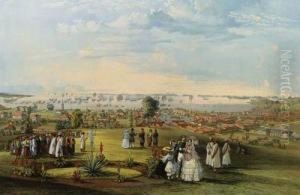John Turnbull Thomson Paintings
John Turnbull Thomson was born in 1821 in Glororum, Northumberland, England. He was not only an influential figure in the early mapping and development of Singapore and New Zealand but also an accomplished artist, surveyor, and engineer. His contributions to the infrastructure and urban planning of these regions during the 19th century were significant, making him a notable figure in both the history of Southeast Asia and New Zealand. Thomson's education and early career were marked by a strong emphasis on engineering and surveying, skills that he would later apply with great effect in the colonial territories of the British Empire.
After his initial education, Thomson moved to Singapore in 1838, where he was appointed as the Government Surveyor by the British colonial administration. In this role, he conducted some of the first detailed surveys of the Singapore and Malacca Straits, contributing significantly to the mapping and development of the region. His work helped lay the foundations for modern Singapore, including the planning of its road system and the reclamation of land from swamps. Thomson's contributions extended beyond engineering and surveying; he was deeply interested in the cultures and languages of the regions he worked in, and he made significant efforts to document and engage with local communities.
In the 1850s, Thomson moved to New Zealand, where he continued his work as a surveyor and played a pivotal role in the exploration and mapping of Otago and Southland. His efforts in New Zealand were instrumental in opening up the region for settlement and development. Thomson's work in New Zealand also included the design and implementation of infrastructure projects, such as roads and bridges, which were critical to the country's expansion and economic growth.
Throughout his career, John Turnbull Thomson also pursued his interest in art, producing a number of sketches and paintings that documented his travels and the landscapes he encountered. His artistic work provides valuable insights into the environments and communities of 19th-century Singapore and New Zealand, offering a unique perspective on the regions during a time of significant transformation.
Thomson passed away in 1884 in New Zealand, leaving behind a legacy of innovation in surveying, engineering, and urban planning, as well as a collection of artistic works that continue to be appreciated for their historical and aesthetic value. His contributions to the development of Singapore and New Zealand are still recognized today, highlighting his lasting impact on the shaping of these countries.

